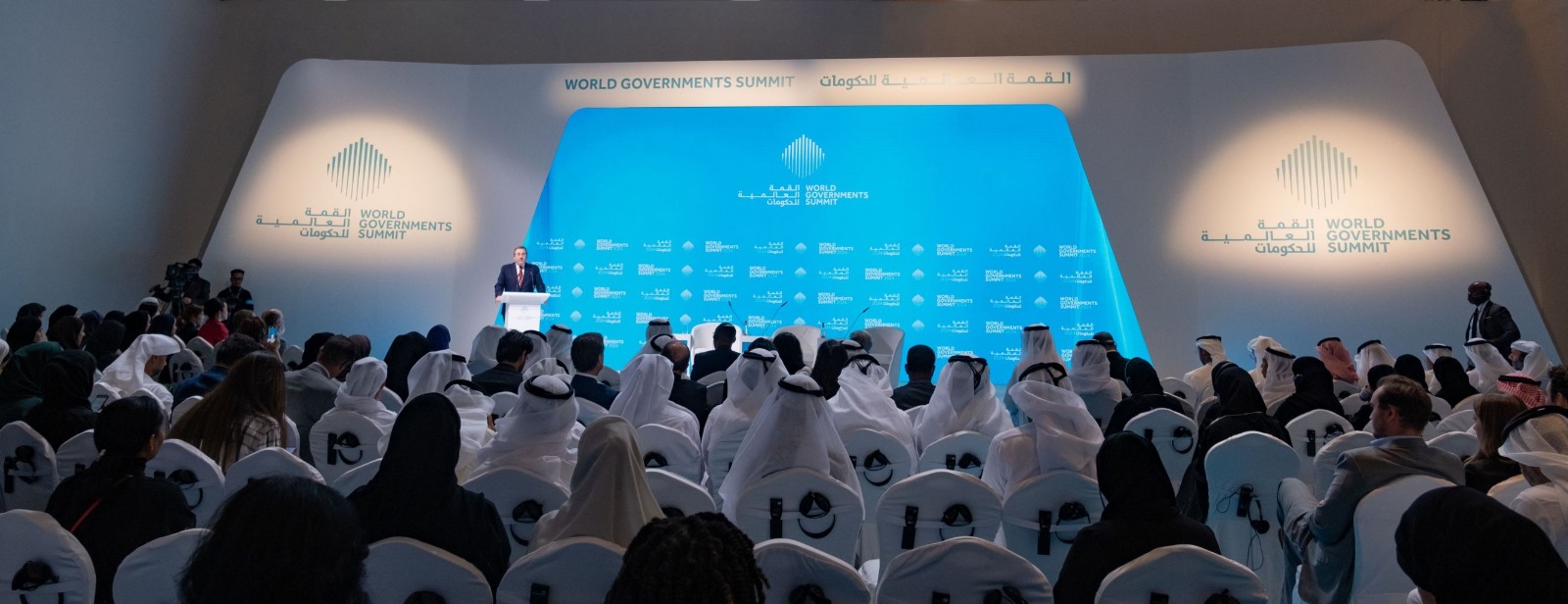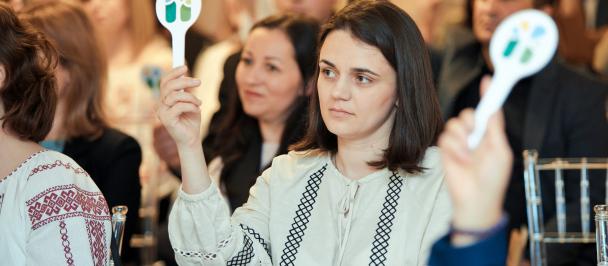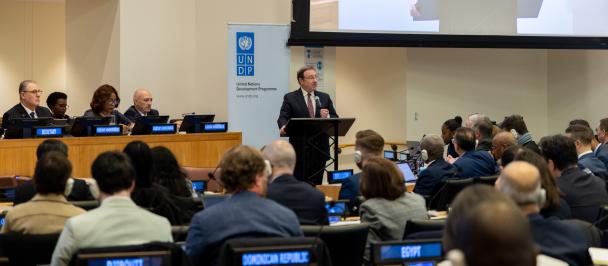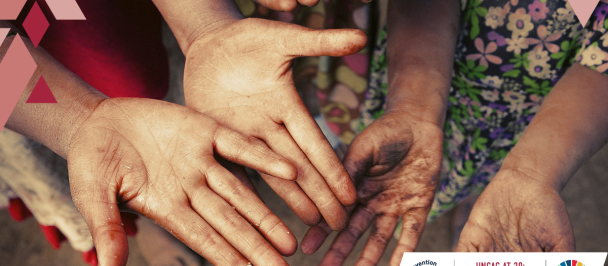World Government Summit Speech: The New Face of Cities and Multi-Dimensional Development
February 13, 2024

UNDP Administrator Achim Steiner delivers his speech during the World Government Summit, in Dubai, on 13 February 2024.
(As prepared for delivery)
Excellencies, Ladies and Gentlemen,
It is a privilege to be here in Dubai to join the World Government Summit.
This timely event challenges us to embrace the concept of foresight and think about how to we can better help to foster urban spaces that are dynamic, equitable, and sustainable.
It comes at a moment when violent conflicts at their highest levels since 1945 and an accelerating climate emergency is changing lives and livelihoods irrevocably.
Cities are also a stark indicator of how far we still have to travel if we are to eradicate poverty by the end of this decade.
Remarkably, as rapid urbanization continues, some 1.1 billion people globally currently live in slums or slum-like conditions.
Indeed, driving change in cities will be where the Sustainable Development Goals (SDGs) are won or lost.
They are where ecological, social, economic, and governance systems converge -- offering an arena to scale transformative action.
For instance, cities account for just 2% of land footprint yet consume about 78% of the world’s energy.
Yet the power of new technologies – everything from A.I. to machine learning – combined with the innate power of human ingenuity, offers the potential to drive step change on our collective efforts to build a greener, more sustainable, and more inclusive future for all.
In that respect, I would like to outline three ‘doors’ to the Future
First, we must heed the lessons of the COVID-19 pandemic and ensure that cities are better prepared for the next crisis.
It is clear that countries, institutions and cities that invested in inclusive innovation, response plans and digital public infrastructure were better prepared to extend vital support to communities during the crisis -- from digital social protection payments to e-healthcare.
At the United Nations Development Programme (UNDP), we keenly recognise the central role of local governance to lay the foundations for resilient recoveries and preparedness for these future risks.
For instance, consider, Gaziantep, in Türkiye, where UNDP is supporting local authorities to not only address the immediate service needs of host communities and refugees but also to modernize urban planning.
For instance, a new facility in the city will be able to process 100,000 tons of solid waste per year.
It also represents a new model of circular economy principles that could be replicated elsewhere: when fully operational, it will generate new revenues for the Gaziantep budget by selling biogas and recycled resources.
Indeed, our support to cities is also cognizant of the fact that development cannot wait until a conflict or crisis is over.
In Ukraine, we are supporting thousands of small and medium-sized enterprises – the engine of local economies to keep operating in spite of war.
That includes our support to rebuild the high-voltage energy grid. This is critical for the uninterrupted supply of electricity, water, and heating to homes and businesses, hospitals, and schools -- benefiting over five million people.
Second, climate change is the defining challenge of our time -- requiring new forms of leadership, political will, and investment, including at the city & local-level.
As part of these efforts to drive change, UNDP’s Climate Promise is supporting over 120 countries to implement their climate pledges, or Nationally Determined Contributions (NDCs)
54 of these NDCs feature aspects that now focus on urban, sub-national, or local climate action.
Driving a just energy transition and decarbonizing transport will be pivotal and cities can learn from other cities in this regard.
For example, in Santiago, Chile authorities made it more attractive for private bus operators to invest in electric buses by ensuring the buses were leased and run by the public transport authority: a public-private partnership model which has resulted in Santiago having the largest fleet of e-buses in the world outside of China.
We are also seeing the need to for more support long-term strategies in cities to help unlock their potential within planetary boundaries.
For instance, consider Pasig City, in the Philippines, where UNDP and local officials have pivoted from focusing solely on tackling plastic waste to revitalizing the urban economy through principles of the circular economy and zero waste.
Since then, the offering has evolved to a Green Economy programme funded by the European Union, through which UNDP will be scaling Pasig portfolio to around 20 cities & locations across the country.
We are also seeing how unlocking new streams of finance for cities will be key -- especially for transformative investments in nature and initiatives with high socio-economic returns.
To take just one example, consider the Care Blocks in Bogota.
Strategically located in areas of the city which do not require the use of transport -- they provide vital services to support women caregivers and their families while leveraging the funding that is available for climate mitigation and adaptation for long-term investments.
Moreover, climate action is being leveraged to attract new investments including in Côte d'Ivoire, where the Bélier Region has established an innovative planning and investment tool that includes local mitigation and adaptation targets.
Indeed, ‘nature-positive’ investments such as Nature-based Solutions for infrastructure or returning land to nature -- including repurposing or rewilding grey infrastructure or encouraging the shared use of existing spaces for working and living -- could create more than 59 million jobs in cities worldwide and generate over $1.5 trillion in annual business value by 2030.
That change is already happening.
Consider the increasing use of nature-based solutions including eThekwini Municipality in South Africa where the rehabilitation of waterways is also creating new jobs.
Third, cities represent the epicentre of innovation and creativity and there is need to support community-based innovators within them.
The UN is putting increased emphasis on this bottom-up development approach including via the groundbreaking UNDP Accelerator Labs network.
To date, it has already surfaced 6,000 southern-led development solutions that can drive progress across all 17 SDGs.
For instance, in Guatemala, the UNDP Accelerator Lab is working with the Municipality of Comalapa to roll-out solar-powered tuk-tuks that are being used to connect vulnerable communities with medical assistance and collect waste.
Or consider the work of our Lab in India, which helped to co-create the GeoAI platform, which uses A.I. and satellite imagery to detect hotspots of air pollution and assisting state authorities to help dramatically reduce it.
In many ways, we Labs just scratching the surface of the potential to support cities and improve the lives of people living in them.
Cities are also rediscovering traditional approaches.
Consider, for instance, Kathmandu in Nepal where the city piloted rooftop gardens with rainwater-harvesting systems, increasing communities’ food and water security.
We must also realise that technology in isolation will not suffice.
It is essential to focus on people’s needs and problems first, as technology and innovation are just tools.
Technical and digital tools need to be designed and built for citizens.
We must also be cognizant of the fact that technology does not always have to be high-tech or cutting-edge, low- or even non-tech like nature-based solutions.
Look to the Philippines, where UNDP supported the implementation of free Wi-Fi sites across the country to enable inclusive and accessible internet for all to narrow the digital divide. There are now some 1,000 access points nationwide.
Indeed, cities must also share new technologies as global public goods.
Consider the Digital Public Goods Registry that hosts a range of ‘oven ready’ solutions that can be adapted immediately by countries.
It hosts solutions such as CityLearn, which uses A.I. to help cities to work out energy needs -- aligning demand with availability of renewable energy to reduces reliance on fossil fuels.8
Yet, at UNDP, we are seeing the clear need for countries and cities to invest in their digital public digital public infrastructure, or DPI.
This represents the ‘railroad tracks’ on which countries can build new services that the public can access 24 hours a day at their fingertips, from e-health to online education.
Indeed, these new digital solutions could accelerate progress on 70% of the SDG targets.
Excellencies, Ladies and Gentlemen,
As we work towards the Summit of the Future later this year, it is clear that cities need tailored support to be better prepared for the next crisis including develop long-term strategies that build inclusivity and resilience.
That includes harnessing innovation to improve the lives of people who live in them and sharing the new solutions that work.
In that respect, I would like to draw your attention to the FutureGov Initiative -- one of 12 UN High-Impact Initiatives intended to accelerate progress on the SDGs -- is part of our integrated support to help government – including local governments like cities -- to be better prepared for the crises to come.
This partnership, led by UNDESA and UNDP, aims to support UN Member States and their cities throughout their public sector transformation journeys.
That includes building public sector skillsets for adaptable, resilient and green institutions and shifting mindsets towards systems thinking and foresight for effective governance and inclusive service delivery -- including through new digital and data tools.
In many ways, that is a reflection of the vital need to insert green, inclusive principles into the genetic code of cities, which will play a pivotal role in shaping the well-being and sustainability of both humanity and the planet.
Thank you.

 Locations
Locations




